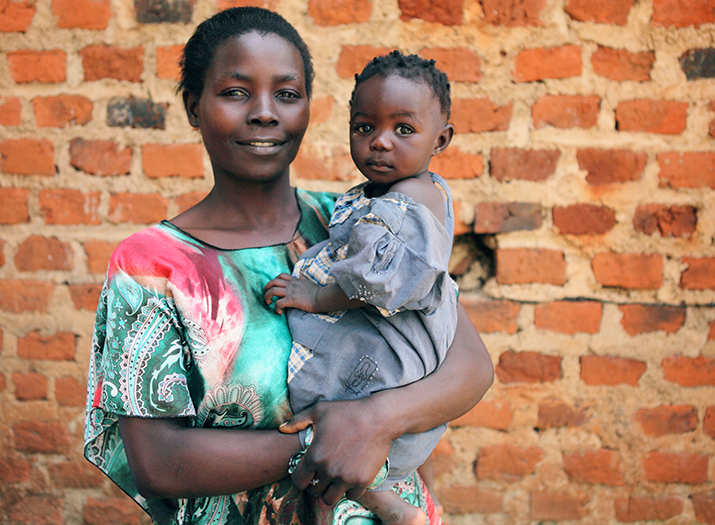Saving Mothers during Childbirth: Using the Vaccine Cold Chain to Keep Oxytocin Cold
Saving Mothers during Childbirth: Using the Vaccine Cold Chain to Keep Oxytocin Cold

In Uganda, 4 in 10 maternal deaths are caused by postpartum hemorrhage, or excessive bleeding after childbirth. Intravenous oxytocin is the treatment of choice for managing postpartum hemorrhage at a health facility but must be stored between 2oC and 8oC to remain effective. The country’s cold chain infrastructure is weak, however, particularly at lower level health facilities, where half of all assisted births occur. The majority of these facilities only have refrigerators that are specifically procured and used for the storage of vaccines. The Expanded Program on Immunization (EPI) staff at health facilities traditionally have not allowed other commodities to be kept in vaccine refrigerators.
Integrating oxytocin into the existing vaccine cold chain is a huge opportunity for resource-limited settings, particularly in Sub-Saharan Africa, where insufficient storage conditions limit its access or compromise the drug’s efficacy, resulting in preventable maternal deaths.
Dr. Abanga Oundo, Medical Superintendent at Bugiri Hospital, Bugiri District, recalls a time he had to administer three to four vials of oxytocin to stop a mother from bleeding to death, when one or two vials should have been sufficient. “Oxytocin was kept in a refrigerator, but power outages are frequent in the hospital.” This can affect the potency of oxytocin, particularly, as Oundo explains, when oxytocin is kept on a tray in the open in the labor ward for long periods of time before being administered.
In 2017, Uganda’s Ministry of Health issued a directive to allow co-storage of oxytocin and vaccines in vaccine refrigerators. However, the initiative was not uniformly implemented; despite being disseminated to all districts only 32% of facilities surveyed were aware of the directive, while only 33% had developed their own guidelines for standardizing co-storage.
Beyond health facilities, storage conditions are a concern at the district level as well. While the national warehouse delivers oxytocin in cold chain conditions to the district level, storage and transportation at the required temperatures to every health facility is not guaranteed. Yet, maternity units never close and require access to quality oxytocin 24 hours a day.
Between October 2018 and February 2020, MSH received an Innovation Fund grant from the Reproductive Health Supplies Coalition, and with support from the USAID-funded Uganda Health Supply Chain (UHSC) Program, spearheaded a cost-effective solution to integrate oxytocin into the vaccine cold chain.
Related: Report and Webinar on Integrating Oxytocin into Vaccine Cold Chain
The work began with the establishment of an integration taskforce, comprised of the Ministry of Health and partners involved in immunization, maternal and child health, and pharmacy and supply chain. The taskforce led the development of implementation guidelines, standard operating procedures, visual aids, and a supervision checklist. In collaboration with the USAID-funded Regional Health Integration to Enhance Services in East Central Uganda Activity (RHITES-EC), these materials were tested over a six-month period, across 34 facilities in two districts – Bugiri and Mayuge – in Eastern Uganda.
The guidelines introduced standardized best practices to correctly store oxytocin and minimize risk to the vaccine cold chain, such as the use of a cold chain box or vaccine carrier to keep oxytocin cold in the maternity ward. Introducing an oxytocin storage form enabled midwives to inventory the amount of oxytocin available on the ward each morning and evening, change ice packs in the cold box to maintain the cold temperature, and order additional supplies from the vaccine refrigerator. The district and health facility staff were instrumental in further refining the draft procedures from the taskforce.
Health facilities created innovative ways to ensure the right conditions to guarantee its potency and keep oxytocin separate from vaccines. “Health centers that do not have containers for keeping oxytocin in the vaccine fridge are using empty Panadol [Tylenol] tins,” explains Titus Mugalya, a Cold Chain Technician in the Mayuge District. “They simply place a visible label on the tin.”
![[Left: Oxytocin compartment in vaccine fridge at Buluguyi Health Centre. Right: Improvised oxytocin container at Bwonda Health Centre. Photo credit UHSC/MSH]](https://msh.org/wp-content/uploads/2020/05/untitled_design_6_0.jpg)
Health workers actively monitored temperatures in the vaccine refrigerator and coordinated between themselves to pick up stock from nearby facilities if there was need. According to Balidawa Misaki, Medicines Management Supervisor in the Bugiri District, at one health center, “the manager in-charge provided transportation to the midwives when their refrigerator broke down, to pick up vaccines and oxytocin from a facility about 3 kilometers away, which had agreed to keep their stock.”
Thanks to the commitment by the Ministry of Health to roll out this guidance nationwide, incorporate storage of oxytocin into mainstream guidelines for immunization programs and medicine management, and prepare a scale-up plan to guide investment by donors and partners’ implementation, health facilities and mothers in Uganda will be assured the quality lifesaving medicine they need.